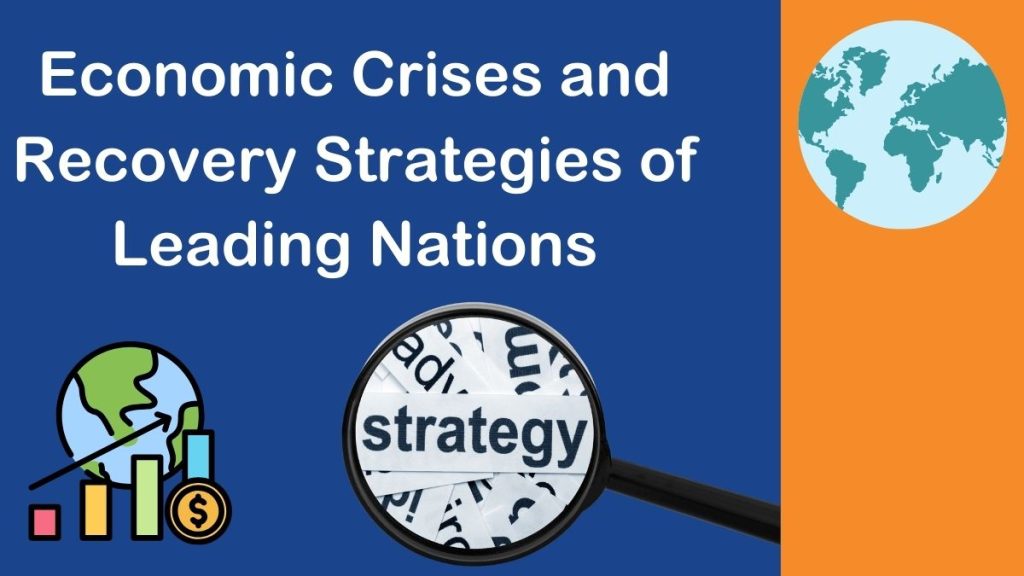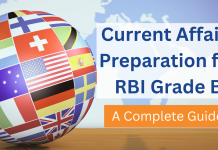Economic crises have been a recurring phenomenon in history, affecting nations worldwide. These crises can arise due to financial mismanagement, geopolitical tensions, pandemics, or natural disasters. Understanding the causes, impacts, and recovery strategies of leading economies is crucial for students preparing for competitive exams, as economic policies shape global stability and growth. Since banking and government exams often This blog explores major economic crises and the recovery strategies adopted by key nations.

Major Economic Crises in History
There have been several major economic crises in history which has affected citizens and the nations on a large scale. Let’s take a closer look at some of them.
The Great Depression (1929)
One of the most devastating economic downturns, the Great Depression began in the United States and spread globally. It was triggered by the stock market crash of 1929, leading to massive unemployment, deflation, and a banking crisis. The U.S. government, under President Franklin D. Roosevelt, introduced the New Deal, which included job creation programs, banking reforms, and public works projects. Keynesian economics was implemented, emphasizing government spending to boost demand.
The Global Financial Crisis (2008)
The Global Financial Crisis is another worrisome economic instability that occurred in the modern world caused by a chain reaction from one crisis. It was created by the collapse of the U.S. housing market and financial sector instability, the 2008 crisis led to a worldwide recession, job losses, and reduced economic growth. While the United States implemented the Troubled Asset Relief Program (TARP) to stabilize banks and introduced stimulus packages, other nations had other strategies. The European Union on the other hand, launched financial rescue packages for struggling economies like Greece and Spain. China on the other hand introduced a $586 billion stimulus package focused on infrastructure and industrial support.
The COVID-19 Economic Crisis (2020)
The COVID -19 pandemic was one of the worst global economic crisis in the modern world. It led to economic slowdowns, supply chain disruptions, and job losses worldwide. Many nations, on the road to recovery took up different strategies. The United States & Europe implemented direct financial aid programs, business loans, and interest rate cuts. India, on the other hand announced the Atmanirbhar Bharat package, focusing on self-reliance and economic revival. China focused on rapid vaccination, digital economy growth, and infrastructure investments.
Recovery Strategies of Leading Nations
When economic crisis like the 2008 situation occurs, nations take some drastic steps to salvage the situation and ease the problem. Let’s take a look at how the different nations recovered from the crisis.
United States
- Monetary Policy: The Federal Reserve cuts interest rates and implements quantitative easing to increase liquidity.
- Fiscal Stimulus: Government spending on social security, unemployment benefits, and infrastructure projects.
- Investment in Technology: The U.S. promotes innovation and digital economy growth to drive long-term economic recovery.
China
- Government-Controlled Investments: Heavy spending on infrastructure and state-owned enterprises to maintain economic stability.
- Trade Diversification: Expansion of trade agreements, such as the Belt and Road Initiative (BRI).
- Focus on Domestic Consumption: Policies promoting local industries and increasing internal demand to reduce dependency on exports.
European Union
- Monetary Union Support: The European Central Bank implements quantitative easing and interest rate adjustments.
- Bailout Packages: Financial aid to struggling member states like Greece, Italy, and Spain.
- Green Economy: Investment in renewable energy and sustainable industries to create jobs and foster long-term economic growth.
India
- Structural Reforms: Implementation of the Goods and Services Tax (GST) and business-friendly policies.
- Self-Reliance Initiatives: The Make in India and Startup India campaigns promote domestic manufacturing and entrepreneurship.
- Agricultural and MSME Support: Subsidies, loan moratoriums, and sector-specific financial assistance.
Lessons from Economic Recovery
Government intervention becomes important in sustaining economic stability and avoiding possible collapse in crisis periods. Effective fiscal and monetary policies, including stimulus packages, interest rate settings, and financial relief, cushion economic downturns and support growth. Without firm intervention, economies can experience long-term recessions, resulting in layoffs, plummeting consumer confidence, and diminished financial markets. Moreover, diversification of an economy is necessary to mitigate risks and ensure stability. Nations with large dependence on one industry, for example, the oil or tourism industry, typically experience huge economic shocks when these industries decline.
Conversely, nations with diversified sectors, for example, manufacturing, technology, and services, recover faster and are able to withstand global disturbances better. International cooperation is also needed when it comes to economic stability. International financial institutions such as the International Monetary Fund (IMF) and the World Bank offer important financial support, policy advice, and structural adjustments to ailing economies. They contribute to stabilizing currencies, restoring investor confidence, and supporting sustainable development.
Apart from this, investments in innovation are one of the best drivers of long-term economic growth. Technological innovations, digitalization, and renewable energy create new jobs that induce productivity and sustainability. Economic resilience and sustainable recovery can be created by governments and firms through research and development priorities. In a more dynamic world economy, forward-looking policies, diversification of manufacturing, global partnerships, and investments in technology all come together to generate economic stability and long-term prosperity.
Summing Up
Economic crises are inevitable, but proactive recovery strategies can mitigate long-term damage. Leading nations adopt a combination of fiscal policies, monetary interventions, and sectoral reforms to navigate economic downturns. Understanding these strategies is essential for students appearing for competitive exams, as economic knowledge is integral to policy-making, governance, and financial stability.
ixamBee specializes in providing expert guidance and resources for banking exams 2024, ensuring that you are well-prepared for the Upcoming Bank Exams like RBI Grade B, NABARD Grade B, IBPS SO, and more. Our courses align with the bank exam calendar 2024, covering all the essential topics. With a focus on the upcoming bank jobs, our Previous Year Papers, BeePedia, SSC CGL, SSC CHSL, SSC MTS and other Mock Tests are designed to help you excel in upcoming banking exams.
Also Read:
International Trade Agreements: RCEP, USMCA, and Indo-Pacific Deals
National Symbols of India 2024: Learn Their Meaning and Significance
Most Important Examinations for Law Graduates in India














